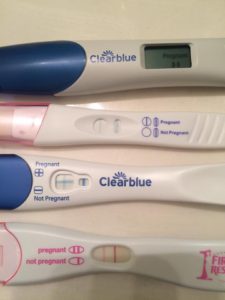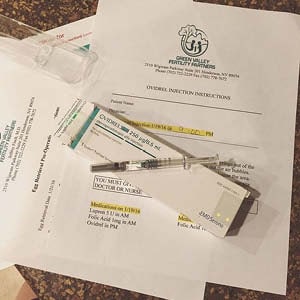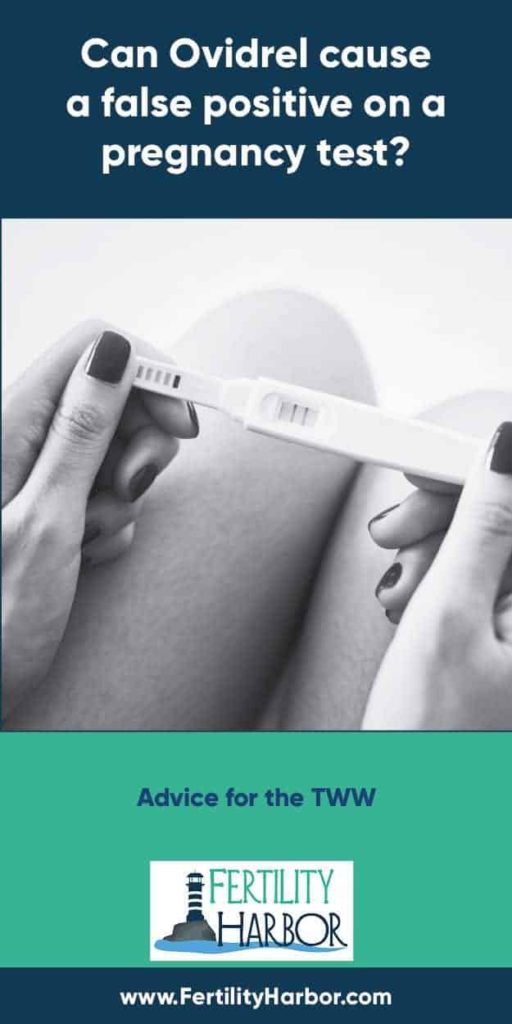This post was reviewed for medical accuracy by Rosalie Gunson, a Certified Registered Nurse Practitioner specializing in fertility care.
When you do medicated fertility cycles, you will likely take a shot to trigger ovulation. (Ovidrel is one common brand name, but you may be familiar with Novarel, Pregnyl, or Profasi instead.)
This injection will make you ovulate within 24-36 hours, which makes it easier to time whatever your next step is — either timed intercourse or an IUI.
But what happens when you take a home pregnancy test afterward? Can the trigger shot make it look like you’re pregnant if you’re not?
Yes, Ovidrel (choriogonadotropin alfa) can cause a false positive if it is still in your system when you take a home pregnancy test. That’s because the shot contains hCG (human chorionic gonadotropin), the same hormone that a pregnancy test tests for.
The trigger shot can take 10-14 days to leave your system, so the safest thing to do is to wait at least that long before taking a home pregnancy test. Ideally, you’d wait until your missed period anyway.
But what if you really don’t want to wait?
Testing Out the Trigger Shot
Some women like to “test out the trigger” by taking several home pregnancy tests over the course of a week. The first test will be positive, but eventually the tests will be negative. If you get a positive test after a negative one, you know you’re really pregnant.
Personally, I hated the idea of looking at positive pregnancy tests unless it was the real thing. It felt like a cruel mind game. And let’s be honest — taking that many pregnancy tests every month gets expensive.
So I never tested out the trigger. Instead, I made myself wait until my missed period to take a home pregnancy test, and sometimes skipped the home test entirely and got a blood test at my doctor’s office at 14 dpo.
But if you really can’t wait and you want to try testing out the trigger, go for it — just make sure you know what to expect, so you don’t get your hopes up for no reason.
What Else Can Cause a False Positive?
When it comes to home pregnancy tests, false positives are far less common than false negatives. That’s because healthy women only produce hCG when we’re pregnant. (Men don’t produce it at all unless they have testicular cancer.)
But you can have hCG in your system for other reasons besides a viable pregnancy, including:
- Chemical pregnancy
- Ectopic pregnancy
- Recent miscarriage
- Certain diseases (try not to Google this, because some of these conditions are serious)
And occasionally pregnancy tests give a false reading because they’re past their expiration date or just plain faulty. So if you get a positive on a home test, definitely do a little happy dance, but get a blood hCG test to confirm the results.
When you’re taking a home pregnancy test that shows a positive result as two lines, remember that the second line does not have to be as dark as the first one. If you see a second line AT ALL, that’s a BFP! For more info, check out Pregnancy Tests: Is it a BFN if the Second Line is Faint?

Blood hCG Tests (“Betas”)
If you’re doing fertility treatment, your fertility specialist has probably encouraged you to come in the office for a blood pregnancy test rather than mess around with peeing on a stick at home. That’s because the blood tests provide a quantitative measure of how much hCG is in your system, while home tests just provide a yes/no answer. Also, a pregnant woman usually has more hCG in her blood than in her urine.
So what’s a good beta hCG result? Non-pregnant women generally have hCG levels under 5 mIU/mL. Many doctors want to see an hCG level of at least 25 mIU/mL before they will consider you pregnant. (I once had a beta level of 7 mIU/mL, which was either the trigger shot sticking around for an unusually long time or the lamest chemical pregnancy ever.)
If your first beta result is 5 mIU/mL or lower, unfortunately that’s a definite answer. The good news is that you will probably get your period very soon, so you’ll be starting the next round of meds before you know it!
(If you don’t get your period within a reasonable time frame and you aren’t pregnant, you may need to take Provera to jump-start a new cycle. Check out my post How to Take Provera When TTC for more info!)
If your first beta result indicates that you’re pregnant, your doctor will want you to come back for one or two more blood tests over the next week to confirm that the levels are increasing as they should. Congratulations! You’re now in Beta Hell.
Beta Hell
When you’re in the Two Week Wait, you think there can’t be a worse form of waiting… Until you find yourself in Beta Hell. You’re finally pregnant, but you’re afraid to get excited. The hours crawl by as you wait for the results, desperate for a high number.
You probably have at least a few friends who have no idea what their beta level was — the doctor just confirmed that they were pregnant with one blood test and that was that.
But infertility patients are usually sent for multiple tests, and the stakes feel higher. It’s easy to start obsessing about each result, especially if you have experienced early loss.
Like I said, a beta result over 25 mIU/mL typically indicates early pregnancy, but the actual numbers are not as important as the doubling rate.
In the early weeks of pregnancy, doctors want to see the number doubling every 48-72 hours. Betas that don’t go up over several days or start to go down indicate that the pregnancy may not be viable.
If your first beta seems low, it doesn’t necessarily mean anything. Even if you know when you conceived (because you know the date of your IUI or IVF procedure), there’s no way to know exactly when the fertilized egg implanted. It could be anywhere from 6 to 10 days after ovulation.
So a low beta number may simply mean that you happened to test pretty soon after implantation, and the level hasn’t had a chance to climb yet.
When you get through Beta Hell, you’re almost ready to leave the fertility clinic behind. So exciting! For more info on the next steps, see my post Graduating from an RE to an OB for Prenatal Care.
Beta Results and Multiples
OK, so low beta numbers don’t necessarily mean bad news (as long as they’re increasing appropriately). What about high numbers? Do high initial beta numbers indicate that you are carrying twins or triplets?
I wish I could give you a definite answer, but it depends. Lots of women have high first beta numbers and just one baby, while some moms of multiples had relatively low beta results.
The number is just a measure of how much HCG is in your system, and pregnant women produce different amounts. The normal range is very wide. (Don’t believe me? Check out the website betabase.)
So if you suspect you may be pregnant with more than one baby, you’ll have to wait until your first ultrasound to find out. Assuming that you are doing all the testing as soon as possible, you’ll probably have your first ultrasound a few weeks after you last blood pregnancy test. At that point, you will be considered 6-7 weeks pregnant.
(Most likely you’ll be all too familiar with internal ultrasounds by this point, but in case you got lucky and conceived quickly, check out my post Do Transvaginal Ultrasounds Hurt? for more info on what to expect.)
In my case, I was pregnant with twins and my beta numbers were on the high side. You can imagine my reaction when I got the result of the first beta from that cycle (at 13 dpo) and it was 268. (That definitely beat the pants off the 7 from the previous cycle!)
Two days later, it was 689. A week after that, it was all the way up to 14,898. I had officially made it through Beta Hell.
For more information about the risk of conceiving multiples on fertility medications, head over to my post Will Clomid Make You Have Twins?
Is There a Chance the Trigger Shot Didn’t Work?

All of this assumes that Ovidrel worked as it was supposed to, and you ovulated “on time.” Since women respond differently to different medications, you may wonder (as you’re sitting in the dreaded Two Week Wait, symptom spotting and anxiously Googling various scenarios) if there’s a chance that the trigger shot failed to do its job.
Yes, there’s a chance — but it’s very slim. The vast majority of women do respond to Ovidrel and ovulate within the window. If there’s doubt, your doctor may order a progesterone test to verify that you did in fact ovulate.
The Bottom Line
Going back to the original question, yes, your Ovidrel shot could give you a false positive on a home pregnancy test if you take it too soon.
I know the last few days of the Two Week Wait are awful, but if you wait until your period is late, you’ll have a lot more confidence that that positive result is the real thing. Good luck!

This post was last updated in March 2025. Most of its content was written in 2018.


 I’m Jenn! Here I am with my beautiful twin boys. My pregnancy was possible thanks to fertility treatment for PCOS.
I’m Jenn! Here I am with my beautiful twin boys. My pregnancy was possible thanks to fertility treatment for PCOS.


